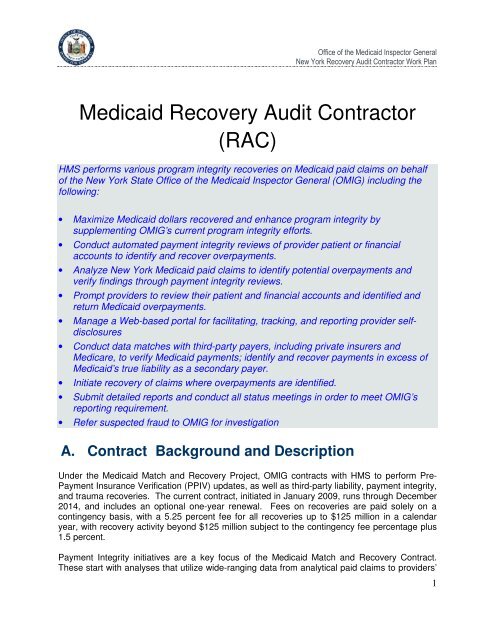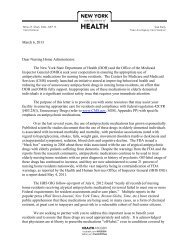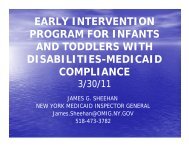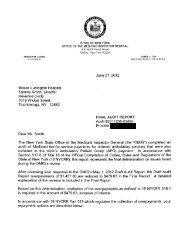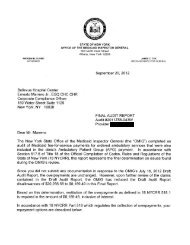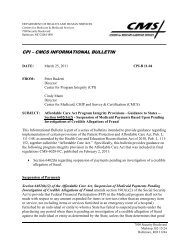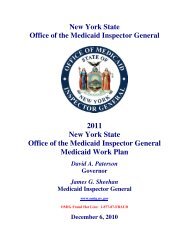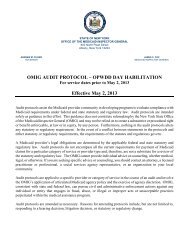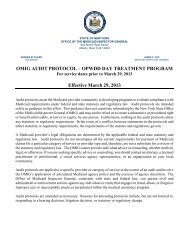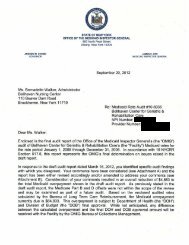Medicaid Recovery Audit Contractor (RAC) - New York State Office ...
Medicaid Recovery Audit Contractor (RAC) - New York State Office ...
Medicaid Recovery Audit Contractor (RAC) - New York State Office ...
Create successful ePaper yourself
Turn your PDF publications into a flip-book with our unique Google optimized e-Paper software.
<strong>Office</strong> of the <strong>Medicaid</strong> Inspector General<br />
<strong>New</strong> <strong>York</strong> <strong>Recovery</strong> <strong>Audit</strong> <strong>Contractor</strong> Work Plan<br />
<strong>Medicaid</strong> <strong>Recovery</strong> <strong>Audit</strong> <strong>Contractor</strong><br />
(<strong>RAC</strong>)<br />
HMS performs various program integrity recoveries on <strong>Medicaid</strong> paid claims on behalf<br />
of the <strong>New</strong> <strong>York</strong> <strong>State</strong> <strong>Office</strong> of the <strong>Medicaid</strong> Inspector General (OMIG) including the<br />
following:<br />
• Maximize <strong>Medicaid</strong> dollars recovered and enhance program integrity by<br />
supplementing OMIG’s current program integrity efforts.<br />
• Conduct automated payment integrity reviews of provider patient or financial<br />
accounts to identify and recover overpayments.<br />
• Analyze <strong>New</strong> <strong>York</strong> <strong>Medicaid</strong> paid claims to identify potential overpayments and<br />
verify findings through payment integrity reviews.<br />
• Prompt providers to review their patient and financial accounts and identified and<br />
return <strong>Medicaid</strong> overpayments.<br />
• Manage a Web-based portal for facilitating, tracking, and reporting provider selfdisclosures<br />
• Conduct data matches with third-party payers, including private insurers and<br />
Medicare, to verify <strong>Medicaid</strong> payments; identify and recover payments in excess of<br />
<strong>Medicaid</strong>’s true liability as a secondary payer.<br />
• Initiate recovery of claims where overpayments are identified.<br />
• Submit detailed reports and conduct all status meetings in order to meet OMIG’s<br />
reporting requirement.<br />
• Refer suspected fraud to OMIG for investigation<br />
A. Contract Background and Description<br />
Under the <strong>Medicaid</strong> Match and <strong>Recovery</strong> Project, OMIG contracts with HMS to perform Pre-<br />
Payment Insurance Verification (PPIV) updates, as well as third-party liability, payment integrity,<br />
and trauma recoveries. The current contract, initiated in January 2009, runs through December<br />
2014, and includes an optional one-year renewal. Fees on recoveries are paid solely on a<br />
contingency basis, with a 5.25 percent fee for all recoveries up to $125 million in a calendar<br />
year, with recovery activity beyond $125 million subject to the contingency fee percentage plus<br />
1.5 percent.<br />
Payment Integrity initiatives are a key focus of the <strong>Medicaid</strong> Match and <strong>Recovery</strong> Contract.<br />
These start with analyses that utilize wide-ranging data from analytical paid claims to providers’<br />
1
<strong>Office</strong> of the <strong>Medicaid</strong> Inspector General<br />
<strong>New</strong> <strong>York</strong> <strong>Recovery</strong> <strong>Audit</strong> <strong>Contractor</strong> Work Plan<br />
patient accounting records. In cases where the analysis suggests that <strong>Medicaid</strong> may have<br />
overpaid in a certain situation, HMS initiates the review process with OMIG’s approval.<br />
Depending on the outcome of the review, the vendor may initiate the recovery process. All<br />
reviews and recoveries are performed at the claim level.<br />
Background<br />
<strong>Medicaid</strong> programs occasionally pay beyond their true liability for various reasons that range<br />
from the inherent asymmetry of information to policy oversights. OMIG, through the Department<br />
of Health (DOH), supplies most of the data that is used for the analysis electronically to HMS via<br />
secured FTP connection on a periodic basis.<br />
On behalf of OMIG, HMS continuously performs data analysis to identify such situations and<br />
recovers funds that were allocated inappropriately. In addition, HMS will seek data from external<br />
entities such as insurance carriers and health care providers that possess information that could<br />
be decisive in determining <strong>Medicaid</strong>’s true liability. With acquired data, the contractor performs<br />
each analysis within the general third-party liability framework, as well as <strong>New</strong> <strong>York</strong>-specific<br />
payment integrity guidelines.<br />
Overview of Our Approach<br />
The process for payment integrity initiatives varies according to the provider type as well as<br />
claim type being reviewed. The following describes the payment integrity review processes,<br />
provider self-disclosure, and data mining initiatives that OMIG and HMS have developed to<br />
enhance identification and recovery of <strong>Medicaid</strong> overpayments. We have included current<br />
initiatives and those under development, as well as potential areas of interest (e.g., some that<br />
would require coordination with other state agencies).<br />
B. Automated Reviews<br />
B.1. Payment Integrity Reviews<br />
The objective of payment integrity reviews is to identify overpayments made to providers<br />
through claim level analyses of patient accounts. Using techniques that comply with <strong>New</strong> <strong>York</strong><br />
<strong>State</strong> provider agreements, HMS will pursue each possible type of overpayment.<br />
B.1.a. Onsite and Desk Reviews - Process Overview<br />
Initial Contact and Data Request<br />
An initial contact is made by mailing a letter and data requests to the patient accounts manager<br />
approximately 15 days prior to the review. The data request is used to determine the scope of<br />
the onsite review, address logistical considerations, respond to preliminary questions, and<br />
provide a general overview of the credit balance processes to the provider. The notification<br />
letter provides information regarding the review such as:<br />
2
<strong>Office</strong> of the <strong>Medicaid</strong> Inspector General<br />
<strong>New</strong> <strong>York</strong> <strong>Recovery</strong> <strong>Audit</strong> <strong>Contractor</strong> Work Plan<br />
<br />
<br />
<br />
<br />
<br />
<br />
Introduction to HMS<br />
Contractual relationship between <strong>New</strong> <strong>York</strong> <strong>State</strong> and HMS<br />
Expectations of the provider<br />
Reason for the review<br />
Request for preview documentation<br />
HMS contact for questions<br />
Shortly after sending the initial mailing, HMS will request specific documents that allow for an<br />
efficient review to be performed. The pre-review documents include:<br />
<br />
<br />
Detailed listing of credit balances with <strong>Medicaid</strong> activity<br />
Accounting system information<br />
The credit balance review program may rely upon the following approaches:<br />
• Desk reviews, which are conducted at an HMS office using provider documentation,<br />
such as patient accounting reports, system screen shots (e.g., demographics,<br />
payments/adjustments, summary of charges, and relevant notes), and copies of RAs,<br />
explanation of benefits (EOBs) forms, and adjustment forms.<br />
• Onsite reviews, for which providers are selected based upon criteria developed by NYS<br />
and HMS’s review team. Designated criteria can include provider size, location, number<br />
of <strong>Medicaid</strong> paid claims, billing activity, past findings, etc. The review consists primarily<br />
of provider personnel inquiries, followed by an analytical review of transactions affecting<br />
the financial accounts of selected <strong>Medicaid</strong> members. HMS also conducts reviews of all<br />
facilities periodically – regardless of billing history.<br />
Review Preparation and Account Selection<br />
HMS staff reviews the documentation that is sent over by providers to reconcile <strong>Medicaid</strong> credit<br />
balances to aged credit balance summary. Staff will trace credit balances from the oldest FYE<br />
data provided to the most current. If significant changes in the number and/or dollar amount of<br />
credit balances are identified, staff reviews the appropriate financial records and interviews key<br />
provider staff to understand the underlying reason for the change.<br />
Accounts are then selected for the desk or onsite review. <strong>Contractor</strong> will review accounts<br />
identified as having outstanding or closed credit balances. Often, the credit balance report is<br />
sorted in order to work the higher credit balances first, along with other accounts that may have<br />
an identifiable credit balance amounts<br />
Additionally, the vendor utilizes the <strong>Medicaid</strong> paid claims file to perform analysis and produce<br />
provider-specific claims listing in advance of an onsite review. HMS will target claims that have<br />
characteristics associated with overpayments (e.g., identified TPL but no TPL payment, low TPL<br />
payment, TPL denial, etc.).<br />
3
<strong>Office</strong> of the <strong>Medicaid</strong> Inspector General<br />
<strong>New</strong> <strong>York</strong> <strong>Recovery</strong> <strong>Audit</strong> <strong>Contractor</strong> Work Plan<br />
Onsite Reviews<br />
Entrance Conference<br />
HMS conducts an entrance conference in order to describe the purpose of review to the patient<br />
accounts manager/controller. During this meeting, the review team is introduced and the<br />
general process for the review is discussed. They will also seek to obtain an understanding of<br />
how the provider processes credit balances.<br />
An entrance conference generally covers the following key topics:<br />
• Information on the necessary steps for the review of <strong>Medicaid</strong> accounts. For all accounts<br />
that are reviewed, HMS will print screen shots and obtain any necessary RAs or EOBs,<br />
work the accounts, and submit to the provider representative for approval.<br />
• In some cases, a request for an updated credit balance report once onsite. HMS will<br />
also request usernames and passwords in order to access the patient financial<br />
accounting systems.<br />
• An explanation of any unusual billing/reimbursement practices.<br />
• Identification of a technical resource that has the authority to sign off on account findings<br />
and resolve account posting questions. Usually, this individual is the provider’s refunds<br />
supervisor.<br />
• Explanation of the fact that a brief exit conference will be held at the end of the review to<br />
discuss findings and address any concerns the provider may have.<br />
Provider Data and Records Assessment<br />
At the beginning of an onsite credit balance review, staff will review the provider data and<br />
records according to the following processes.<br />
• Review A/R reconciliation to the G/L to ensure the entire credit balance population has<br />
been identified. This ensures that the review encompasses all known credit balances.<br />
• Review the reconciliation of all cash clearing accounts in order to verify that all deposits<br />
are reversed and applied to individual patient accounts. Any carryover balances should<br />
be explained. <strong>Medicaid</strong> payments greater than 30 days old will be noted, and HMS will<br />
request that the money be refunded back to <strong>Medicaid</strong> if a disposition cannot be<br />
identified.<br />
• Review cash posting accuracy to ensure payments are being applied to the correct<br />
account. If discrepancies in the sample are identified, staff performs appropriate testing<br />
to ascertain the extent of the posting problem and develops an appropriate course of<br />
resolution.<br />
• Review previous adjustment requests made to <strong>Medicaid</strong>. In some cases, adjustment<br />
requests may be misrouted and the transactions never completed.<br />
4
<strong>Office</strong> of the <strong>Medicaid</strong> Inspector General<br />
<strong>New</strong> <strong>York</strong> <strong>Recovery</strong> <strong>Audit</strong> <strong>Contractor</strong> Work Plan<br />
Identification of Overpayments<br />
HMS will accumulate findings by review type and patient type (inpatient and outpatient). All<br />
accounts identified as a refund to <strong>Medicaid</strong> will be entered into our database, along with<br />
pertinent information, such as patient name, account number, MID, DOS, TCN, refund amount,<br />
and reason for refund. Each account that is reviewed will be logged into our database even if<br />
there are no financial ramifications. In cases where no refund is due to <strong>Medicaid</strong>, an explanation<br />
will be recorded.<br />
Once the findings are logged, staff will require signoff on each account that the provider agrees<br />
on. Accounts with discrepancies will include findings from both the provider and reviewer.<br />
Exit Conference<br />
During the exit conference, the HMS representative will meet with the provider’s staff, review<br />
findings, and agree upon a deliverable date for a draft report. The purpose of the exit<br />
conference is to discuss findings, make any recommendations, appropriately answer questions<br />
about the review/findings, and discuss next steps. Any issues that the provider presents are<br />
noted and concerns documented. The provider is permitted to view the summary worksheets<br />
and provide explanations for any deviations from policy.<br />
Provider Approval<br />
As part of closing a review, HMS representatives will document all findings and obtain signoff<br />
from the authorized provider representative. The provider signoff indicates agreement with the<br />
findings. Should the provider disagree with specific findings, their explanations are documented<br />
and forwarded to NYS for final decision. The majority of disagreements are resolved during the<br />
review process and will require no intervention by NYS.<br />
Report<br />
Following an onsite review, HMS will compile a report that summarizes the credit balance<br />
findings and includes a written narrative, including a summary of the review process, findings,<br />
and recommendations.<br />
<strong>Recovery</strong> of Overpayments<br />
At the conclusion of each onsite review, HMS receives a signed attestation from the provider for<br />
each identified credit balance. Before these claims are placed into the recovery process, a<br />
match against our database of previously-recovered claims, to ensure that claims are not<br />
recovered by both the credit balance and third-party review processes. Any claims that match<br />
are pulled out for additional review.<br />
HMS also validates the data elements associated with the claims that will be submitted for<br />
adjustment. During this process, any claims that cannot be validated against the <strong>Medicaid</strong> paid<br />
claims data are flagged for follow-up by our credit balance team. The follow-up includes QA of<br />
all data entry processes, re-review of provider documentation and, if necessary, contacting the<br />
provider for further clarification.<br />
5
<strong>Office</strong> of the <strong>Medicaid</strong> Inspector General<br />
<strong>New</strong> <strong>York</strong> <strong>Recovery</strong> <strong>Audit</strong> <strong>Contractor</strong> Work Plan<br />
The remaining overpaid claims are then placed into the queue for the next submission cycle.<br />
Providers are notified that the validated claims will be placed into the upcoming void and<br />
adjustment submission.<br />
Provider Education<br />
This process includes a strong provider education component to prevent future overpayments<br />
from occurring. Credit balances are caused by a variety of reasons—including claims<br />
adjudication issues, patient financial issues, coordination of benefit issues, and the inherent<br />
complexity of the healthcare financial environment.<br />
To ensure overpayments are reduced to the greatest extent possible, the contractor will not only<br />
work with NYS, but we will also leverage our experience in working with providers and provider<br />
associations to educate them on preventing overpayments from occurring.<br />
B.1.b. eReviews – Electronic <strong>Audit</strong>ing<br />
OMIG is working with HMS to develop initiatives that will allow <strong>New</strong> <strong>York</strong> <strong>State</strong> to conduct<br />
electronic reviews to determine precise <strong>Medicaid</strong> overpayments. These initiatives will be driven<br />
primarily by cross-matching of paid claims data. By obtaining adjudicated claims information<br />
(both payments and denials) from third party payers, <strong>Medicaid</strong> will now be able to check its<br />
payments against third party payments. Below are some examples of payment integrity checks<br />
that we will be performing. Taken together, they represent an approach to coordination of<br />
benefits analysis that will enable OMIG to institute a universal payment integrity program that<br />
can identify and validate overpayments concurrently.<br />
The billing practices described below do not always lead to a <strong>Medicaid</strong> overpayment; that<br />
depends on the actual amounts involved. However, HMS has identified distinct tendencies in<br />
how providers interpret billing guidelines and how actual billings appear to change as<br />
circumstances change – e.g., <strong>Medicaid</strong> fee-schedule, third-party fee schedule, <strong>Medicaid</strong><br />
reimbursement rule when paying secondary to commercial vs. Medicare, etc. Electronic auditing<br />
capability will eliminate such biased tendencies.<br />
eReviews will include all provider types for which third-party payer claims detail is obtained.<br />
Examples of Electronic <strong>Audit</strong>s and Reviews<br />
Duplicate Payment Review<br />
<strong>Contractor</strong> will identify duplicate payments through third-party paid claim matches. When it is<br />
identified that a provider failed to report a third-party payment and was subsequently paid by<br />
both the third-party payer and <strong>Medicaid</strong> as primary, the state will recover the <strong>Medicaid</strong> payment.<br />
Balance Billing<br />
Providers sometimes receive payments equal to the difference between the <strong>Medicaid</strong>-allowed<br />
amount and the primary commercial payment for each claim whose reported commercial<br />
6
<strong>Office</strong> of the <strong>Medicaid</strong> Inspector General<br />
<strong>New</strong> <strong>York</strong> <strong>Recovery</strong> <strong>Audit</strong> <strong>Contractor</strong> Work Plan<br />
payment is less than the <strong>Medicaid</strong>-allowed amount for the same service(s). This is inconsistent<br />
with <strong>Medicaid</strong>’s billing and reimbursement policies, which allow only for payment equal to the<br />
sum of any patient responsibility charges left by the commercial payer.<br />
When HMS identifies through paid claims matches that a provider correctly reported a thirdparty<br />
payment but failed to indicate the patient liability, the state will recover the resulting<br />
overpayment.<br />
Charge Review (Bill <strong>Audit</strong>)<br />
For claims that are dependent on provider charges (high-dollar injection drug charges,<br />
pharmacy claims, etc.), HMS will perform targeting and comparative analysis using third-party<br />
payer data to identify potential claims for review of itemized bills against submitted charges.<br />
When unsubstantiated charges are identified, recovery may occur. The accuracy of the thirdparty<br />
payer data minimizes unnecessary requests for itemized bills and medical records to<br />
providers.<br />
B.2. Prompted Provider Self-Disclosures<br />
Section 6402(d) of the Patient Protection and Affordable Care Act of 2010 (ACA) reinforces the<br />
obligation for providers to self-disclose identified overpayments. To assist in the recovery and<br />
analysis of provider-identified overpayments, HMS is initiating prompted provider self-disclosure<br />
mailings. Providers will be required to respond to the requests with identified overpayments,<br />
including reasons why the overpayment occurred. Providers will be required to sign an<br />
attestation if they report that no overpayments exist.<br />
These efforts will supplement OMIG’s existing Self-Disclosure Program by identifying providers<br />
based on analyses of billings and <strong>Medicaid</strong> payments and prompting them to conduct a self<br />
review.<br />
B.2.a. Provider Outreach<br />
Initially, HMS will request self-disclosure via mailing notification. After implementation of the<br />
provider portal, self-disclosure requests will be performed electronically for providers that<br />
choose to use the Web-based platform. The vendor will track recoveries on the claim level, as<br />
well as provider responses, which will be available in report format as requested and required<br />
by OMIG.<br />
B.2.b. Providing Examples<br />
Wherever possible, the vendor will include examples of potential billing and reimbursement<br />
issues that may result in <strong>Medicaid</strong> overpayments. Providers are required under existing state<br />
law to perform a complete review of their patient and financial accounts and report and return<br />
identified overpayments. The purpose of supplying “live” examples is to demonstrate to<br />
7
<strong>Office</strong> of the <strong>Medicaid</strong> Inspector General<br />
<strong>New</strong> <strong>York</strong> <strong>Recovery</strong> <strong>Audit</strong> <strong>Contractor</strong> Work Plan<br />
providers the types of overpayments that may exist and show our commitment to identifying<br />
overpayments through data mining should the provider neglect to perform their duties.<br />
C. Complex Reviews<br />
C.1. Long Term Care<br />
C.1.a. NAMI Overpayments<br />
<strong>Contractor</strong> will perform manual reviews of nursing claims to identify overpayments that resulted<br />
from incorrect reporting of net adjustable monthly income (NAMI) amounts. There will be a<br />
separate data mining initiative that will look for opportunities to automate the initial identification<br />
which will minimize the burden on all stakeholders. This will require additional data feeds from<br />
providers and/or the <strong>Office</strong> of Long Term Care.<br />
D. Additional <strong>RAC</strong> Provisions<br />
D.1. Provider Portal<br />
OMIG and HMS are developing a payment integrity “provider portal,” through which<br />
overpayments can be reported and tracked. The primary purpose of the provider portal is to<br />
offer both providers and OMIG a Web-based platform which streamlines the communication of<br />
overpayment issues. To summarize the main functions, the provider portal will:<br />
1. Streamline self-disclosure process for all providers. Facilitating self-reviews and<br />
disclosures helps providers better understand billing and reimbursement issues–<br />
internal and external–and better position themselves to educate employees and<br />
maintain stronger compliance programs.<br />
2. Automation of refund data aggregation. HMS will track self-disclosures at the claim<br />
level–documenting actual overpayments and reason codes. Doing so enables us to<br />
conduct further analyses to identify intra- and inter-provider issues across the<br />
program. Through such analyses, HMS “flags” <strong>Medicaid</strong>-paid claims with potential<br />
issues and sends them to providers for an expanded review, while providing OMIG<br />
with data to assist in determining future eMedNY edits that will prevent<br />
reoccurrences of the identified issue.<br />
3. Use as a delivery vehicle for desk reviews and eReviews. Providers will be notified<br />
via e-mail when new claims are available for review. HMS will track and analyze<br />
responses via the portal in a paperless environment.<br />
8
<strong>Office</strong> of the <strong>Medicaid</strong> Inspector General<br />
<strong>New</strong> <strong>York</strong> <strong>Recovery</strong> <strong>Audit</strong> <strong>Contractor</strong> Work Plan<br />
Providers who utilize the portal will have the ability to search and locate overpayments (both<br />
OMIG-initiated and provider self-disclosed) and use simple data entry functions to report<br />
overpayment reasons.<br />
D.2. Underpayments<br />
Separate from communications regarding overpayments, contractor will report underpayments<br />
identified through both complex and automated reviews on a quarterly basis. Identified<br />
underpayments will only be reported when, through analysis, it is found that a claim was<br />
incorrectly billed at a lower level of payment than appropriate. <strong>Contractor</strong> will not report<br />
underpayments in situations where the provider failed to include a provided service on a claim,<br />
nor will it process or report underpayments self-disclosed by providers.<br />
D.3. Provider Scoring & Fraud Referrals<br />
HMS will initiate provider scoring based on the results of our integrated reviews. The scoring<br />
will utilize tangible data including, but not limited to zero fill behavior, claims adjustments,<br />
responsiveness, targeted claims results and self-disclosure analysis. The provider scorecard<br />
gives OMIG an additional tool to help recognize specific areas where a provider may be<br />
deficient and additional education is necessary while aiding in the identification of potential<br />
provider fraud cases.<br />
When HMS Suspects Fraudulent Billing<br />
When, through claims or provider-level scoring analysis, HMS suspects a provider of fraudulent<br />
billing activities, that provider, along with back-up documentation pertaining to that facility will<br />
immediately be forwarded to OMIG for investigation. HMS will assist OMIG with research and<br />
data investigation as is requested, but will not pursue recovery from the suspected provider.<br />
D.4. Provider Appeals<br />
HMS actively mitigates provider disputes and appeals by engaging providers and giving them<br />
an opportunity to voice their points-of-view prior to initiating recoveries. When conducting a<br />
Payment Integrity Review, staff reviews each potential overpayment at the claim level to<br />
precisely identify the overpayment reason and the amount. We also review our overpayment<br />
findings with providers prior to initiating recoveries. Such review with providers is conducted<br />
during the review and/or at the exit conference. HMS’s certified staff provides accurate and<br />
9
<strong>Office</strong> of the <strong>Medicaid</strong> Inspector General<br />
<strong>New</strong> <strong>York</strong> <strong>Recovery</strong> <strong>Audit</strong> <strong>Contractor</strong> Work Plan<br />
detailed review determinations, including clinical summaries and other documentation to explain<br />
why the decision was made. By reviewing specific claims, rather than sampling and/or<br />
extrapolation, and obtaining provider attestation prior to initiation recoveries, we are largely able<br />
to avoid provider disputes and appeals.<br />
In addition, if a provider disputes our findings during a review, HMS immediately notifies OMIG<br />
of the dispute and provides documentation detailing why the claim was determined to be an<br />
overpayment. If resolution requires policy clarification, OMIG may consult Department of Health<br />
(DOH)’s counsel to obtain a clear ruling on whether the provider is entitled to the payment.<br />
Although HMS makes efforts to address all provider concerns and disputes prior to initiating<br />
recoveries, there may be situations where HMS will initiate recoveries without obtaining a<br />
provider attestation of their agreement with our findings. This may be true of many complex<br />
reviews that require a peer review of medical services.<br />
If a provider disagrees with a recovery initiated by HMS or OMIG, they may request an<br />
administrative hearing to contest an adverse determination under the Administrative Procedures<br />
Act. During a hearing, the provider will be given an opportunity to present written and/or oral<br />
arguments. All records and documents in possession of the agency will be offered and made<br />
part of the record in accordance with the law. Once a final determination is made by the<br />
administrative law judge (ALJ) overseeing the hearing, each agency involved in the hearing will<br />
maintain an index by name and subject of determination. Lastly, providers also have the right to<br />
appeal a hearing decision to NY Supreme Court under the Article 78 proceedings.<br />
In the case that an appeal cannot be closed through an informal process and is escalated to a<br />
hearing, HMS will continue to assist the state until resolution is obtained. Our staff resources<br />
will be available to answer questions, explain the review process and rationale for the<br />
determination, and otherwise defend the determination that we made. Staff will comply with all<br />
<strong>New</strong> <strong>York</strong> <strong>State</strong> and federal rules, regulations, policies, and procedures and contract<br />
requirements regarding provider appeals.<br />
D.5. Coordination with Ongoing Other <strong>State</strong> Agency<br />
Activities<br />
In order to reduce the burden on providers, the vendor will coordinate all provider reviews with<br />
OMIG to ensure no overlap occurs. Additionally, previously identified claims that are already<br />
included in ongoing <strong>New</strong> <strong>York</strong> <strong>State</strong> or federal payment integrity efforts will be removed from<br />
reviews.<br />
10
<strong>Office</strong> of the <strong>Medicaid</strong> Inspector General<br />
<strong>New</strong> <strong>York</strong> <strong>Recovery</strong> <strong>Audit</strong> <strong>Contractor</strong> Work Plan<br />
D.5.a. Identification of <strong>New</strong> Findings<br />
When a new data-mining target is identified by the vendor, the claims are presented to OMIG,<br />
explaining the methodology used to identify the finding and state and federal regulations to<br />
establish good cause for the review of the claim. If it is determined the finding conflicts with<br />
ongoing activities being performed by the state or another entity, the claims are removed from<br />
the queue of claims for provider review.<br />
D.5.b. Supplement to Ongoing OMIG Activities<br />
At OMIG’s request, the vendor will assist in ongoing recovery identification and payment<br />
recapture efforts.<br />
D.6. Reporting to OMIG<br />
A minimum of two monthly status meetings will be attended by key HMS project staff, during<br />
which HMS will update OMIG on progress, evaluate any problems, and discuss immediate next<br />
steps. The vendor will be responsible for scheduling meetings, preparing the agenda and<br />
preparing any supporting materials which may be required.<br />
HMS will produce any and all additional reports as required by OMIG.<br />
11


